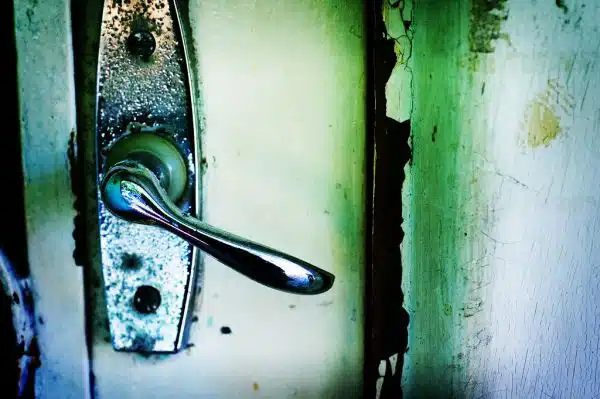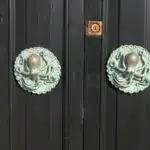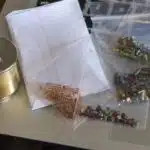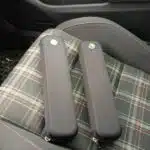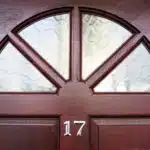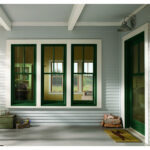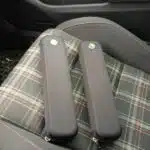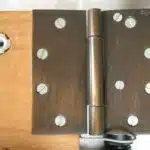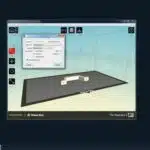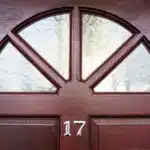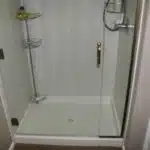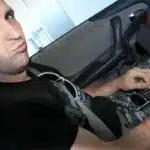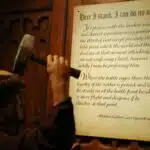A door knob is an essential component of any household as it allows for easy access and security. However, a door knob can fall off due to various reasons such as wear and tear, improper installation or even accidental force. When this happens, it can be frustrating and inconvenient, especially if the door is frequently used. Fortunately, fixing a door knob that has fallen off does not always require professional assistance. With the right tools and knowledge, you can easily fix the problem yourself.
In this article, we will discuss the steps on how to fix a door knob that fell off. We will guide you through each step in detail to ensure that you have a smooth experience with repairing your door knob. By following these steps, you will not only save money from hiring a professional but also gain valuable knowledge on basic home repairs that can come in handy in the future. So grab your tools and let’s get started!
Assessing The Damage
As a handyman/woman, it is important to know the common causes of a door knob falling off. One common cause is wear and tear over time. As the door knob is used frequently, the screws holding it in place can become loose, causing it to fall off. Another cause could be improper installation. If the door knob was not installed correctly in the first place, it may eventually come loose and fall off.
Assessing the damage involves checking if any pieces of the door knob are broken or missing. If any parts are damaged beyond repair, they will need to be replaced. In addition, check if the screw holes in the door are stripped or damaged, as this will also need to be addressed before reattaching the door knob.
Possible solutions for fixing a fallen-off door knob include replacing any damaged parts or reattaching loose screws with a screwdriver. If there is damage to the screw holes in the door itself, using wood filler can fix this issue. Once all necessary repairs have been made, follow proper installation procedures when reattaching the door knob to ensure that it stays secure and does not fall off again.
Having assessed the damage and identified possible solutions, it’s time to gather necessary tools for repairing a fallen-off doorknob.
Gathering The Necessary Tools
To fix a door knob that has fallen off, you will need to gather several essential tools. These tools are necessary to complete the task correctly and efficiently without causing further damage. Before starting, ensure that you have all the required tools at hand.
The first tool you will need is a screwdriver. Ensure that it is of the appropriate size for your door knob screws. The second tool is a pair of pliers, which will help you grip and turn the spindle located inside the door knob base. You might also require a hammer or mallet to lightly tap the spindle in case it’s stuck or jammed. Lastly, you will need some lubricant like WD-40 or lithium grease to apply on the spindle for easy removal.
Common mistakes when fixing a door knob include using incorrect tools or using too much force when trying to remove the spindle from its housing, which can cause damage to the surrounding woodwork. Alternative solutions include calling in a professional if you do not feel comfortable doing it yourself or if there is extensive damage to the door jamb.
In preparation for removing the door knob, it’s essential to have all necessary tools within reach and avoid damaging any part of the door frame while removing it. With these tools in hand, we can now move on to removing the broken doorknob and replacing it with a new one without causing any damages along with our way.
Removing The Door Knob
You have successfully removed the door knob from its socket, and now it’s time to inspect the problem. Before doing so, make sure you have a good understanding of how door knobs work. The mechanism of a door knob is quite simple: there are two screws that hold the two halves of the knob together, and these screws also secure the knob to the spindle. The spindle runs through the latch, which engages with the striker plate on the door frame.
One common cause of a door knob falling off is worn out screws. Screws can become worn over time due to constant use or rusting caused by exposure to moisture. When this happens, they may loosen or break off entirely. Another possible cause could be that the lubricating mechanism inside the knob has dried up or become clogged with dirt and debris. This can affect how smoothly the latch moves in and out of its housing and may cause it to stick or get jammed.
To fix these issues, you will need to replace any worn-out screws with new ones that are properly sized for your door knob. You should also lubricate all moving parts inside the knob using a silicone-based lubricant spray or oil-based lubricant. Make sure not to use petroleum-based products such as WD-40, as they can corrode plastic parts in your door knob.
Inspecting other parts will help ensure that your door knob will function properly again. In the next section, we’ll discuss how to inspect each part of your doorknob assembly and identify any other potential problems that may need attention before reassembling everything back together again.
Inspecting The Parts
Checking components is an important step in fixing a door knob that fell off. It’s essential to identify whether the problem lies with the knob itself or with other parts, such as the latch or strike plate. Begin by examining the knob and checking for any visible damage or wear and tear. If the knob seems intact, move on to inspecting the other components.
The latch is a small metal piece that extends from the edge of the door and engages with the strike plate when you turn the knob. Over time, it can become misaligned or damaged, causing problems with the door’s function. Check that the latch is properly aligned with the strike plate and that it moves smoothly in and out of its housing. If there are any issues, consider replacing either component.
Maintenance tips can help prevent future problems with your door knobs. Regularly lubricating all moving parts will help keep them functioning smoothly and extend their lifespan. Additionally, tightening screws and bolts periodically can prevent them from coming loose over time, which can cause major malfunctions down the line.
Now that we have checked all of our components for any visible damage or wear and tear while also learning maintenance tips to prevent future issues let’s move on to identifying what caused our doorknob to fall off in our next section.
Identifying The Problem
Examining hardware is the first step in identifying the problem when a door knob falls off. This involves inspecting both the knob and the mechanism that connects it to the door. Common causes of a door knob falling off include loose screws, worn out parts, or damage to the hardware.
Loose screws are often the culprit when a door knob falls off. Over time, screws can become loose due to repeated use or exposure to changes in temperature and humidity. It is also possible for screws to become stripped or damaged, making them unable to hold the knob in place. Inspecting and tightening any loose screws is a simple solution to this problem.
Worn out parts or damage to the hardware can also cause a door knob to fall off. This can occur when internal components break down or external parts become damaged due to wear and tear. Identifying which part is damaged and replacing it is necessary in these cases. In some situations, it may be more cost-effective to replace the entire knob rather than just one part.
Replacing The Screws
Once you have removed the old screws from your door knob, it’s time to find replacement screws that will work for your particular door knob. The first step in finding replacement screws is to determine the size and type of screw you need by checking the manufacturer’s specifications for your door knob. If you don’t have access to this information, there are a few other ways to find out what size screw you need. You can take one of the old screws to a hardware store and ask for assistance, or you can use a caliper tool to measure the diameter and length of the screw.
If you are unable to find replacement screws that fit your door knob, there are alternative solutions available. One option is to use adhesive tape or glue instead of screws. This method works best for lightweight door knobs that do not require much force to turn. Another solution is to replace the entire door knob with a screwless model that uses a different locking mechanism, such as a push button or magnetic lock. However, keep in mind that these alternative solutions may not be as secure as traditional screw-in door knobs.
Now that you have found replacement screws or an alternative solution for your door knob, it’s time to install them and secure them tightly in place. In the next section, we will discuss how to properly tighten the latch plate on your door frame so that your newly installed door knob functions correctly and securely.
Tightening The Latch Plate
After replacing the screws, you should check if the door knob is aligned. Misaligned knobs can cause problems with latching and opening/closing of the door. To adjust the alignment, loosen the screws on the latch plate and move it up or down until it fits snugly into the strike plate. Tighten the screws again once you have adjusted it to your satisfaction.
Another important step in fixing a door knob that fell off is lubricating its mechanism. A dry mechanism can cause friction, leading to difficult turning of the knob or even damage to its internal parts. Lubricate all moving parts with a silicone-based lubricant to ensure smooth operation of your door knob. Use a small amount of lubricant and wipe off any excess with a cloth.
After adjusting alignment and lubricating mechanism, it’s time to reattach your door knob. Line up both sides of the knob with their respective holes in the latch assembly and push them together until they click into place. Once they are attached securely, test out your newly-fixed knob by turning it several times to make sure everything works properly.
Reattaching The Door Knob
Ironically, the door knob has fallen off and now it is time to reattach it. The good news is that this is a common problem that can be easily fixed. However, before jumping into the repair process, it’s important to understand some key points.
Firstly, door knob alignment is crucial for the smooth functioning of the lock mechanism. If the door knob is not properly aligned with the latch bolt, then it may not turn smoothly or even get stuck. Secondly, fixing loose screws is often an underlying cause of a falling door knob. Therefore, before attaching the door knob back in place, make sure to tighten all screws and check if any are missing.
To reattach the door knob securely, follow these steps:
- Remove any remaining screws from both sides of the door.
- Place one side of the door knob through the hole on one side of the door.
- Align both sides of the doorknob so that they fit perfectly together.
- Insert new screws through both sides of the doorknob and tighten them firmly.
Once you have completed these steps and are confident that everything is secure and aligned correctly, you can move onto testing your newly repaired doorknob without any concerns about it falling off again.
Testing The Door Knob
After reattaching the door knob, it’s important to ensure proper installation. One common issue with door knobs is that they may become loose over time due to wear and tear or improper installation. To prevent this, make sure the screws are tightly secured into the door.
Another common issue is a misaligned latch. This occurs when the latch doesn’t properly line up with the strike plate on the door frame, causing difficulty in opening and closing the door. To fix this problem, you may need to adjust the position of the strike plate by moving it up or down or side-to-side until it aligns with the latch.
Testing the door knob is crucial before considering your job complete. Make sure it turns smoothly and locks properly from both sides of the door. If there are any issues, double-check that everything was installed correctly and try adjusting the strike plate if necessary. With these steps taken care of, your door knob should be functioning properly once again.
To adjust the strike plate, start by removing any screws holding it in place on the frame of your door. Then, use a chisel or file to adjust its position until it lines up perfectly with your doorknob’s latch. Once you’ve made these adjustments, reattach any screws you removed earlier and test out your newly aligned doorknob!
Adjusting The Strike Plate
Adjusting the Strike Plate:
When a door knob falls off, one of the most common problems is that the strike plate has become misaligned. The strike plate is the metal plate on the door frame where the latch from the door knob enters when you close the door. If this plate is not properly aligned with the latch, then it can cause difficulty opening and closing your door, or even prevent it from staying closed at all.
To troubleshoot this problem, first remove any screws from the strike plate and pull it away from the door frame. Inspect both the plate and frame for any signs of warping or damage. If everything appears to be in good condition, try adjusting the position of the strike plate on the frame. You may need to enlarge or shift its opening to better align with your lock’s latch.
If these steps do not resolve your issue, you may need to replace your entire strike plate with a new one that suits your lock mechanism. In some cases, an older or incompatible strike plate can cause issues with a newer lock mechanism, so be sure to check compatibility before purchasing any replacement parts.
Transition into subsequent section about ‘lubricating the lock mechanism’:
Now that we’ve covered how to adjust your strike plate for optimal performance, let’s move on to another factor that affects how smoothly your door functions: lubricating its lock mechanism.
Lubricating The Lock Mechanism
Sometimes, a door knob can become stiff and difficult to turn. This can be caused by a lack of lubrication in the lock mechanism. Applying lubricant to the lock can help to alleviate this issue and make the knob easier to turn.
To apply lubricant, begin by removing the knob from the door. Then, locate the keyhole and spray a small amount of lubricant into it. Use a cloth or paper towel to wipe away any excess lubricant. Next, insert the key into the lock and turn it back and forth several times to distribute the lubricant evenly throughout the mechanism.
Common issues that can arise from a lack of lubrication include difficulty turning the knob, sticking keys, or even a jammed lock. By regularly applying lubricant to your door knobs, you can prevent these issues from occurring and ensure that your locks function properly for years to come.
- Five tips for applying lubricant:
- Use a silicone-based lubricant.
- Apply only a small amount of lubricant at a time.
- Avoid spraying too much into the keyhole as this may cause drips.
- Wipe away any excess with a cloth or paper towel.
- Test out your newly-lubricated knob before reinstalling it on your door.
Now that you have applied some much-needed lubrication to your door knob’s lock mechanism, it is time to move on to reinstalling the trim plate onto your door.
Reinstalling The Trim Plate
To reinstall the trim plate, you will need to align it properly with the door knob hole. Start by placing the plate over the hole and aligning it correctly. Once aligned, use a screwdriver to secure it in place with the screws provided. Be sure to tighten them firmly but not too tight, as this could cause damage to the plate or knob.
If you are looking to update your door’s hardware, this is a great opportunity to consider painting your trim plate or buying a new one altogether. Painting your existing trim plate can give it a fresh look that matches your home’s decor, while buying a new one allows you to choose from a range of styles and finishes.
Once you have reinstalled the trim plate and knob, be sure to clean up any debris or dust that may have accumulated during the process. This will ensure that your door not only functions properly but also looks great. In the next section, we’ll cover how to clean up the area and make any necessary touch-ups.
Cleaning Up The Area
When cleaning up the area after a door knob has fallen off, it is important to sweep up any debris to ensure the area is clean.
Once the area is free of any debris, the screws that were holding the door knob can be disposed of properly.
Care should be taken to ensure that screws are not lost or left in the area, as these can be a hazard for anyone walking in the area.
An appropriate container should be used for the screws, such as a small bag or a screw organizer, to ensure that they are not scattered around the area.
Sweeping Up Debris
Clearing debris is an essential step in fixing a door knob that fell off. When the knob falls off, it can cause small metal pieces and screws to scatter on the floor, making it difficult to move around. Therefore, clearing up the debris is necessary before starting any repair work.
When clearing debris, it is important to take safety measures such as wearing gloves and using a broom and dustpan. This will protect your hands from sharp metal pieces while also ensuring that all debris is removed without leaving any residue behind. Additionally, make sure to dispose of the debris properly by placing them in a trash can.
Once you have cleared up all debris, you are ready to start fixing the door knob. Remember that taking safety precautions while cleaning up the area is just as important as repairing the door knob itself. By following these steps and exercising caution throughout the process, you can ensure that your door knob will be fixed safely and effectively.
Disposing Of Screws
When fixing a door knob that has fallen off, it is essential to clear up all debris before starting any repair work. This includes small metal pieces and screws that may have scattered on the floor. Disposing of screws properly is an important step in cleaning up the area.
One option for disposing of screws is to recycle them. Many cities offer recycling programs for metal items such as screws, which can reduce the environmental impact of throwing them away. Another option is to repurpose the screws for other projects or donate them to a local hardware store or maker space.
Proper screw disposal not only helps keep the work area clean and safe but also contributes to reducing waste and protecting the environment. By considering recycling options or repurposing materials, you can make a positive impact while completing your home repair project.
Preventing Future Issues
Preventive measures should be taken to ensure that door knobs stay in good condition. One of the most common causes of door knob malfunction is wear and tear due to constant use. To prevent this, it is important to lubricate the door knob regularly with a silicone-based lubricant. This will keep the knob functioning smoothly and prevent it from becoming loose or falling off.
Another preventive measure is to tighten any loose screws on the door knob periodically. Loose screws can cause the knob to become wobbly and eventually fall off. In addition, make sure that all screws are properly anchored into the door so that they don’t loosen over time.
It’s also important to choose high-quality door hardware that is durable and long-lasting. Investing in quality hardware will save you money in the long run because you won’t have to replace your knobs as frequently. Finally, always use your door knobs gently and avoid slamming doors as this can cause unnecessary stress on the hardware.
These preventive measures should help you maintain your door knobs in good condition for longer periods of time. However, sometimes even with these measures being taken, problems may still arise with your door knobs. In such cases, it’s important to know when to call a professional for help in fixing them properly.
Knowing When To Call A Professional
When it comes to fixing a door knob that fell off, many homeowners might be tempted to DIY this task. However, there are certain situations where calling for professional help is necessary. Knowing when to DIY and when to call for assistance can save you time, money, and stress in the long run.
Assessing Professional Help is crucial when deciding whether or not to fix your door knob on your own. If you have no experience with repairing door knobs, it may be best to seek professional assistance. Additionally, if the issue is complex or requires specialized tools, it’s best left to the experts. Attempting a repair without proper knowledge or tools can lead to further damage and higher costs.
The Cost of DIY Mistakes should also be considered before attempting any repairs yourself. While DIY projects can save you money upfront, mistakes can end up costing even more in the long run. For example, if you incorrectly install a new door knob, it could cause damage to your door frame or make it difficult to open and close the door properly. These issues may require additional repairs that could have been avoided by calling a professional initially.
Remember that calling for professional help isn’t admitting defeat; rather, it shows wisdom in knowing when help is needed. By assessing the situation carefully and considering the cost of potential mistakes, you can determine whether fixing your door knob yourself is feasible or if calling a handyman/woman would be more appropriate. Always prioritize safety and quality over saving a few bucks when it comes to home repairs!
Conclusion
Do you have a door knob that’s fallen off? Don’t panic, it’s a common problem that can be fixed with the right tools and knowledge. First, assess the damage and gather the necessary tools, including a screwdriver and pliers. Next, remove the door knob and inspect the parts to identify the problem.
Once you’ve identified the issue, you can reinstall the trim plate and clean up the area. To prevent future issues with your door knob, make sure to tighten screws regularly and lubricate moving parts. However, if you’re not confident in your ability to fix the problem yourself or if there are more serious issues at play, don’t hesitate to call a professional.
As a handyman/woman or home repair expert, it’s important to have basic knowledge of how to fix common household problems like a fallen off door knob. With these steps in mind, you can confidently take on this DIY project and save yourself time and money in the long run. Remember: proper maintenance is key to preventing future issues with your door knobs!
Image Credits
- “Door Knob” by visualdensity (featured)

